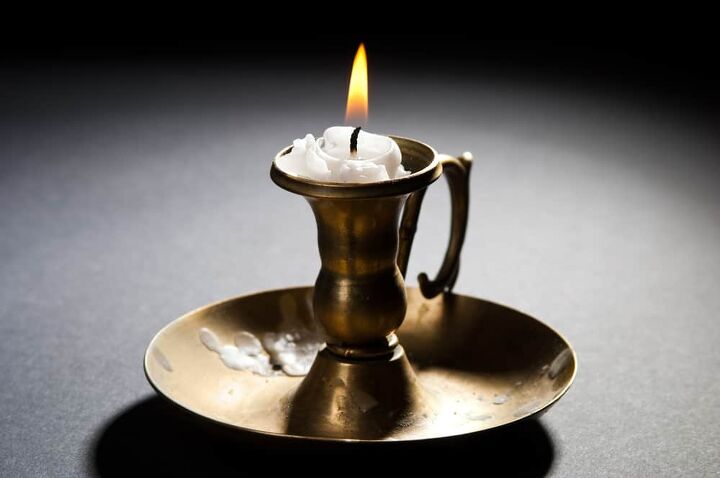How To Keep Brass From Tarnishing (Quickly & Easily!)

Brass is one of the most popular metals for home decor, especially if you are fond of the “old world” style. It’s coppery, yet a little more gold. Unfortunately, brass also happens to be one of the more high-maintenance metals, so it’s important to know how to keep brass from tarnishing.
Brass tarnishes when it’s exposed to oxygen. To keep brass from tarnishing, clean it thoroughly and apply a clear sealer to prevent air from reaching the brass. The coating wears down over time, so reapply it every four years to keep your brass shiny and beautiful.
Protecting your brass items is a must if you want to use them on a regular basis. Understanding how to make protection against tarnishing simple isn’t that hard. If you want to avoid scrubbing metals day after day, you’ll be proactive in preventing tarnishing; let’s talk about it.
How To Keep Your Brass From Tarnishing
In order to get your brass safe from the ravages of oxygen, you are going to have to treat your brass. To do this, follow the detailed steps below:
- Start by rubbing down the brass with a soft cloth dunked in paint thinner. This removes any old coatings you may have. Once it’s been rubbed all over, wipe it down with another damp rag and leave it to dry for 12 to 24 hours.
- Next, remove any current tarnish by polishing your brass with salt and lemon juice. One teaspoon salt to 1/2 cup lemon juice will suffice. If you don’t have lemon juice available, you can use vinegar. Leave the mixture on for 10 minutes to work away the tarnish. Then, polish away until it’s shiny, then wash it with regular soap and water.
- Take a paintbrush and apply a coat of polyurethane to the brass. Then, let it dry. Most brass fixtures will need at least two hours to dry.
- Add three more coats of polyurethane before you assume that your brass will be safe for long-term use. Though polyurethane does fade, it will take years before you have to re-up on your coatings if you follow these procedures.
- Give your brass a full 24 hours to dry. Do not move or touch the brass during this time.
A Note About Using Vinegar On Brass
If you’re low on lemon juice, using vinegar on brass will not harm it…as long as it’s a one-off issue. However, it’s important to note that regularly polishing your brass with vinegar can pose a problem. Vinegar will eat away at the zinc before it starts on the copper. The more exposure to acid brass gets, the more pronounced the issue becomes.
You might be wondering what this means for the brass you have. The end result is that you might start seeing the brass turn pink over time. Some also claim that this may cause your brass to tarnish faster than it normally would. However, there’s not much solid evidence to this. If you want to avoid having pink brass, skip vinegar unless you’re really hard-pressed.
Are There Any Easier Ways To Prevent Brass From Tarnishing?
There are, but they won’t be as permanent as polyurethane coats. The most common way to make sure that your brass doesn’t tarnish as frequently is to “polish” it by buffing it with a little car wax. Much like how it works to protect car coats, car wax can act as a thin protective coat. However, we do not suggest this as a solution for brass items that will come into contact with food.
If you want to use your brass in the kitchen or want to go with a slightly less chemical option, opt for linseed oil. Rubbing brass with linseed oil gives it a moisture-locking coat that helps prevent oxidation. This, in turn, prevents tarnishing and prolongs the polished look of your brass in a pinch.
Is Tarnishing A Sign Of Brass Decay?
Though tarnishing is unsightly and may affect the feel of brass fixtures, it’s not a sign of decay. Even tarnished brass can last over 1,000 years with the proper restoration procedures. Rather than assume brass is decaying, it’s better to just assume that the tarnishing you’re seeing means that it has been a little neglected.
What Causes Brass To Tarnish?
Oxidation, pure and simple. With that said, exposure to oxygen alone is not the only thing that can cause the brass to tarnish. Exposure to salt, in particular, happens to be pretty bad for brass and may accelerate the oxidation process. This means that exposure to things like saltwater, rain, and similar items can end up harming your brass.
Is Tarnishing Always Removable From Brass?
Once in a while, you might have an item that looks like it’s been neglected for ages. It looks beaten up, tarnished to all heck, and it may even be barely recognizable as brass. While it may look bad, the truth is that the vast majority of all brass can be cleaned up to its old vigor with the right effort and tools. Here’s what you need to know:
- The longer an item has gone without polishing, the longer it will take to scrub away the tarnish. You may need to leave the polish on for longer, use a baking soda/vinegar paste, or something similar. You also might need to scrub using a toothbrush instead of a soft brush.
- Do not use a heavily abrasive scrubber. While some abrasion can be alright, using something like steel wool can scratch brass and metals like it. Stick to toothbrushes, rags, soft cloths, and microfiber. (This is also true for cleaning bronze, by the way!)
- If you have extensive damage to your brass items, you may need to get a commercial restoration kit. Commercial restoration kits are made with chemicals that are strong enough for heavy cleaning, but gentle on brass. They’re a favorite of antique restorers as well as professional home restoration crews.
If you’re having a lot of trouble with a particular item, especially mechanisms like hinges or locks, it might be best to call a professional cleaner. More detailed projects like these might take more work than you initially think.
Does WD-40 Clean Tarnish From Brass?
WD-40 is not just a good cleaner for shower doors; it’s an amazing cleaner for brass, gold, bronze, and other metals. (Then again, that’s to be expected considering that WD-40 was primarily made as a polish and lubricant for metals and automotive work.) It’s a truly remarkable polish and tarnish remover that can be used on almost any brass fixture.
Using it is easy as pie.
- Start off by spraying WD-40 liberally all over the brass item. You want to coat it completely. To reduce messes, do this procedure outside, ideally on stone or metal. If you can’t do this outside, do it indoors in your workshop.
- Let the WD-40 sink in for 10 to 30 minutes. This is a must if you want to loosen up the tarnish. Smaller problems can go for a shorter time. Brass items that have extensive tarnishing will need 30 minutes or more.
- Take a clean rag and rub the item in question with it. Rubbing in gentle circles is key, though you may need to do a little more work with stubborn stains. Thankfully, enough WD-40 will make most tarnish break apart.
- Continue to buff the item in circles until the WD-40 removes all the tarnish. You should see WD-40 dry up as it does its magic. From there, you should have a sparkling clean brass item.
Commercial Products That Polish Brass
If you simply want to hop over to the home improvement store and purchase something to polish your brass, you’ll find several options.
Here’s a list of popular products you can use for polishing your brass:
- Bar Keepers Friend
- Brasso
- Wright’s Brass Polish
- Twinkle Brass & Copper Cleaning Kit
- Blue Magic
Related Questions
Does ketchup really clean brass?
Though it’s not one of the most conventional ways to clean brass, it is absolutely possible to use ketchup to clean your brass fixtures. The acids from tomatoes are enough to melt away most of the dirt and grime that attaches itself to the brass. To use it, apply the ketchup directly to the brass, let it sit for 10 minutes, and scrub.It is worth noting that the salt from the ketchup can make the brass tarnish a little faster if you do not rinse it off. To further protect your brass, use salt-free ketchup if at all possible.Other kitchen staples that can polish brass are a combination of lemon and baking soda, lemon and salt, or flour, salt, and white vinegar. You can mix one teaspoon of baking soda with the juice from half a lemon to make a paste. Apply it to the brass with a soft cloth, let it sit for about 30 minutes, then rinse with warm water and dry.Or, you can cut a lemon in half and cover it with salt, about one teaspoon. Use the lemon as a polisher on your brass, squeezing as you rub it on, then rinse with warm water and dry.
Due to the high content of copper in brass, it’s possible to have your fingers or wrists turn green if you wear them as part of your jewelry. In order to prevent this from happening, most jewelers will coat their jewelry with a protective layer of polyurethane. However, it’s possible to have this coating wear off from time to time. Further protective treatments may be necessary.
What causes the black spots visible on brass?When you see black spots on your brass, that’s a sign that the copper in the brass has oxidized. Thankfully, this is pretty safe and can be removed easily. Meanwhile, if you notice powdery green spots that are rapidly spreading throughout the item, you may have active corrosion.
When working with brass, it’s important to differentiate between active and safe corrosion. Active corrosion needs to be addressed quickly, by a professional, in order to ensure that your brass will remain usable for years to come. Safe tarnishing, on the other hand, will be fine with a cleaning.

Ossiana Tepfenhart is an expert writer, focusing on interior design and general home tips. Writing is her life, and it's what she does best. Her interests include art and real estate investments.
More by Ossiana Tepfenhart










![Finishing Basement Without Permit [Is It Really Illegal?]](https://cdn-fastly.upgradedhome.com/media/2023/07/31/9070078/finishing-basement-without-permit-is-it-really-illegal.jpg?size=350x220)













![How To Reset A Whirlpool Cabrio Washer [In 5 Easy Steps!]](https://cdn-fastly.upgradedhome.com/media/2023/07/31/9076531/how-to-reset-a-whirlpool-cabrio-washer-in-5-easy-steps.jpg?size=350x220)


